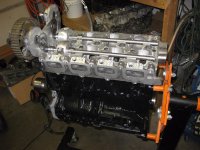goldenfab
Cast Iron
- Joined
- May 25, 2016
- Location
- USA Prescott , Arizona
Hi All,
I am getting into fairly complexcasting and pattern work - currently working out the bugs of a 4 cylinder head for a car.
I have been using Alibre for all my CAD work. Its got me by mostly but I can't do non-planar parting lines, and it can't really do surface modeling. I used Blender and reverse engineered some patterns via mesh modeling but its too time consuming and mesh models are not the best for machining. Also creating non-planar parting lines was very labor intensive. I have played around with Fusion 360 using its T-Spline surfacing functions but its not very robust (partly because of user error).
I am looking for advice on a budget minded software/workflow where I can take a preliminary solids model and reverse engineer an existing solid model so as to get smoother free-flowing shapes. One specific example of a need as follows. When I design castings that have complex cores they are the result of leftover space after getting all the structural design modeled as a solid. The internal cavity (sand core) is the leftover space. But it is not good to have sharp edges like you get from prismatic solids modelers like Alibre and everything needs a draft angle about a parting line. Due to the complex shapes, solids modelers can not always compute draft and fillets, hence I am trying to solve the problem by re-designing the sand core with a surface modeler. A very important feature I must have is the ability to split molds/patterns that have a non-planar parting line, does not have to be automatic one button press solution but a software/workflow that does not take hours to do it would be sufficient. Here is a screen shot of the initial design of sand core shape.

This is a screenshot from blender of what I would want to redesign it as.

Notice the non-planar parting line seen via the colors from draft analysis.

I downloaded a demo of Rhino and the T-Splines plugin and am in the process of learning it. It seems a lot more robust than Fusion 360 as far as T-Splines are concerned when I draft less than ideal topology which I am working at improving. I would like to avoid spending the extra bucks on the T-Splines plugin if I can help it, I downloaded it to fix a surface I screwed up in Fusion. Anyways, my real question is do you think Rhino would be a good solution to the need I defined and what other software should I consider?
Thanks,
Adam
I am getting into fairly complexcasting and pattern work - currently working out the bugs of a 4 cylinder head for a car.
I have been using Alibre for all my CAD work. Its got me by mostly but I can't do non-planar parting lines, and it can't really do surface modeling. I used Blender and reverse engineered some patterns via mesh modeling but its too time consuming and mesh models are not the best for machining. Also creating non-planar parting lines was very labor intensive. I have played around with Fusion 360 using its T-Spline surfacing functions but its not very robust (partly because of user error).
I am looking for advice on a budget minded software/workflow where I can take a preliminary solids model and reverse engineer an existing solid model so as to get smoother free-flowing shapes. One specific example of a need as follows. When I design castings that have complex cores they are the result of leftover space after getting all the structural design modeled as a solid. The internal cavity (sand core) is the leftover space. But it is not good to have sharp edges like you get from prismatic solids modelers like Alibre and everything needs a draft angle about a parting line. Due to the complex shapes, solids modelers can not always compute draft and fillets, hence I am trying to solve the problem by re-designing the sand core with a surface modeler. A very important feature I must have is the ability to split molds/patterns that have a non-planar parting line, does not have to be automatic one button press solution but a software/workflow that does not take hours to do it would be sufficient. Here is a screen shot of the initial design of sand core shape.

This is a screenshot from blender of what I would want to redesign it as.

Notice the non-planar parting line seen via the colors from draft analysis.

I downloaded a demo of Rhino and the T-Splines plugin and am in the process of learning it. It seems a lot more robust than Fusion 360 as far as T-Splines are concerned when I draft less than ideal topology which I am working at improving. I would like to avoid spending the extra bucks on the T-Splines plugin if I can help it, I downloaded it to fix a surface I screwed up in Fusion. Anyways, my real question is do you think Rhino would be a good solution to the need I defined and what other software should I consider?
Thanks,
Adam



